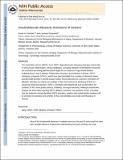Small-Molecule Allosteric Activators of Sirtuins
Author(s)
Sinclair, David A.; Guarente, Leonard Pershing
DownloadGuarente_Small-molecule.pdf (1.316Mb)
OPEN_ACCESS_POLICY
Open Access Policy
Creative Commons Attribution-Noncommercial-Share Alike
Terms of use
Metadata
Show full item recordAbstract
The mammalian sirtuins (SIRT1–7) are NAD[superscript +]-dependent lysine deacylases that play central roles in cell survival, inflammation, energy metabolism, and aging. Members of this family of enzymes are considered promising pharmaceutical targets for the treatment of age-related diseases including cancer, type 2 diabetes, inflammatory disorders, and Alzheimer's disease. SIRT1-activating compounds (STACs), which have been identified from a variety of chemical classes, provide health benefits in animal disease models. Recent data point to a common mechanism of allosteric activation by natural and synthetic STACs that involves the binding of STACs to a conserved N-terminal domain in SIRT1. Compared with polyphenols such as resveratrol, the synthetic STACs show greater potency, solubility, and target selectivity. Although considerable progress has been made regarding SIRT1 allosteric activation, key questions remain, including how the molecular contacts facilitate SIRT1 activation, whether other sirtuin family members will be amenable to activation, and whether STACs will ultimately prove safe and efficacious in humans.
Date issued
2013-10Department
Massachusetts Institute of Technology. Department of Biology; Paul F. Glenn Center for Biology of Aging Research (Massachusetts Institute of Technology)Journal
Annual Review of Pharmacology and Toxicology
Publisher
Annual Reviews
Citation
Sinclair, David A., and Leonard Guarente. “Small-Molecule Allosteric Activators of Sirtuins.” Annual Review of Pharmacology and Toxicology 54, no. 1 (January 6, 2014): 363–380.
Version: Author's final manuscript
ISSN
0362-1642
1545-4304